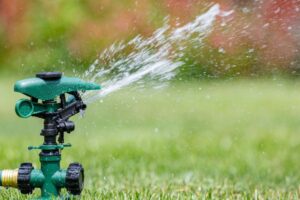Ultimate guide to lawn watering
Lawn Watering Recommendations; by month

Lawn watering requirements, January – March (Winter Months)
During the winter months in Central Indiana, lawns are typically dormant, and there is minimal growth. Precipitation levels are often sufficient to maintain soil moisture. Therefore, there is no need for additional irrigation during this period. In fact, it’s essential to avoid overwatering, as this can lead to waterlogging and root damage.Lawn watering requirements, April
As temperatures begin to rise in April, your lawn may start to come out of dormancy. However, early spring usually brings enough rainfall to meet the water requirements of your lawn. Monitor the weather and only consider supplemental watering if there is a prolonged dry spell. This is typically why irrigation companies don’t open irrigation systems in April, because there is enough natural rainfall.Lawn watering requirements, May
May marks the transition to warmer weather, and your lawn will likely require more water as it begins to actively grow. According to the Purdue Turf Science Department, aim for about 1 to 1.5 inches of water per week, either from rainfall or irrigation. This can be divided into two or three watering sessions to allow for proper absorption. Only supplement with water if there is no natural rainfall that week.Lawn watering requirements, June
June is typically one of the rainiest months in Central Indiana, which is great news for your lawn. However, if there are extended dry periods, continue to follow the 1 to 1.5 inches of water per week guideline. Be mindful of evaporation rates, especially during hot spells, and adjust your watering schedule as needed.Lawn watering requirements, July – August (Summer Months)
Summer in Central Indiana can be scorching, and your lawn’s water needs increase significantly during this period. To prevent drought stress and keep your lawn healthy, increase your watering frequency to 1.5 to 2 inches of water per week. Water deeply and early in the morning minimize evaporation. Avoid watering in the evening to prevent fungus growth.Lawn watering requirements, September
As temperatures start to cool in September, your lawn’s water requirements will gradually decrease. However, continue to provide 1.5 inches of water per week if there’s insufficient rainfall. This helps your lawn recover from the stress of summer and prepare for the coming winter. This is also an excellent month to help repair your lawn with aeration and overfeeding to aid in the recovery process.Lawn watering requirements, October
Fall is an excellent time for lawn care in Central Indiana. The cooler temperatures and reduced evaporation rates mean you can cut back on watering to around 1 inch per week. Focus on deep watering to encourage strong root growth before winter.Lawn watering requirements, November – December (Late Fall and Early Winter Months)
During the late fall and early winter months, your lawn will enter dormancy once again. There is typically enough moisture from rainfall to meet your lawn’s minimal water requirements. Avoid unnecessary watering during this period, as overwatering can be detrimental. This is a great time for your winterize fertilization treatment.Tips for Efficient Lawn Watering
1. Use a Rain Gauge: Install a rain gauge in your yard to measure the amount of rainfall your lawn receives. This will help you determine whether supplemental irrigation is necessary.2. Adjust Sprinkler Systems: If you have an automated sprinkler system, adjust it seasonally to accommodate changing weather conditions and lawn growth patterns.
3. Water Early: Watering early in the morning reduces water loss due to evaporation, ensuring that more water reaches the root zone. DO NOT water in the evening. This can lead to more fungus damage in your lawn.
4. Water Deeply: Apply water deeply to encourage deep root growth and make your lawn more drought-resistant. This happens by longer durations waterings so that the water can soak deeper into the soil.
5. Avoid Overwatering: Overwatering can lead to shallow roots, disease, and weed problems. This typically happens when you water too frequently.